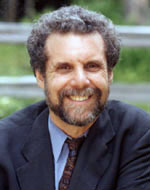Two types of meditation, two types of brain patterns?
 In The Meditative Mind, a worthwhile tour of major meditative traditions, Daniel Goleman (picture, Wikipedia entry) quotes Joseph Goldstein, a teacher of insight meditation:
In The Meditative Mind, a worthwhile tour of major meditative traditions, Daniel Goleman (picture, Wikipedia entry) quotes Joseph Goldstein, a teacher of insight meditation:
It’s simple mathematics: all meditation systems either aim for One or Zero—union with God or emptiness. The path to the One is through concentration on Him, to the Zero is insight into the voidness of one’s mind.
I’d like to do some brain scans to illuminate this simple division of styles. One would expect that One-based meditation would involve parts of the brain associated with identity and boundaries, the Zero-based style pattern-matching and categorization.
If any readers know of similar kinds of research, I’d love to know about it.

September 9th, 2005 at 22:57
First off, this ‘split’ between meditation practices aimed either at ‘oneness’ or ‘emptiness’ – as claimed by Goldstein – results largely from a significant misinterpretation of early Buddhist meditative practice – thanks mostly to those backing the ‘Vipassana’ style (which has essentially become a brand at this point). Check out this essay:
http://accesstoinsight.org/lib/authors/thanissaro/onetool.html
As for studying brain states of meditators, very little is currently known, but there’s a major project in the works ( via the UC Davis neuroscience dept.) that could further the field significantly should it get funding:
http://mindbrain.ucdavis.edu/content/ShamathaInfo
September 12th, 2005 at 10:35
I’m certain that you’re familiar with this book already, but “Why God Won’t Go Away” by Andrew Newberg and Eugene D’Aquili goes into the different contours of these two styles of meditation very thoroughly, in terms of endocrinal, physiological and neurochemical states. Hopefully this will be of use to you, even if only as a recap.
And I love this blog, by the way. Thanks for always making me think! 🙂
September 22nd, 2005 at 06:37
Just a couple of things:
1. I haven t read it, but i once stumbled across a book called “Zen and the Brain”.
http://www.amazon.com/exec/obidos/tg/detail/-/0262511096/qid=1127394570/sr=8-1/ref=pd_bbs_1/002-4729665-2279254?v=glance&s=books&n=507846
2. Goldstein: “all meditation systems either aim for One or Zero—union with God or emptiness. ”
Well, I’d say christian meditation, notwithstanding the important neo platonician streams, aims for Being, rather than for One.
To illustrate this briefly, let s recall the Exodus: “I AM”, or “I am the one who is”, as opposed to “I am the One”. According to the Bible of Jerusalem, Yahve is an archaic form of the verb ‘to be’
December 10th, 2005 at 12:58
My name is Stanley Cortis, a fifth year architecture student reading for a degree in Architecture and Civil Engineering Faculty at University of Malta, Europe. I am currently working on my dissertation project which my topic is ‘Mysticism in Architecture’. Basically since I am going to limit to the Christian Catholic Religion, but I will refer to certain religions.
I will appreciate if you give me your views regarding this subject. In line with good academic research I am bound to cite sources used in my work.
Thank you in anticipation
Stanley Cortis
May 11th, 2006 at 11:40
Dear Stanley,
I would like to tell you something about God – God is an experience in itself – he is life – he is something wonderful – you know when God created nature he was the architect -the master. Today architects are taking the role of the MASTER. So it is important that they realise the responsability that is on their shoulders – their creations are there to stand the passage of time. They will leave their footsteps not in sand but in rock – deeply set in rock.
I hope you get my message and understand what I am trying to convey.
In the Love of God
Pietra
April 27th, 2008 at 19:17
what was the two types of meditation for the two types of brain patterns?